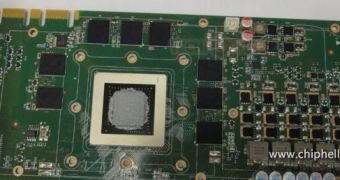By the end of this month, Nvidia plans to update its product portfolio with the company’s first 28nm graphics card based on the Kepler architecture, the GeForce GTX 680, which sources seem to imply will feature a new dynamic overclocking technology.
German website Heise.de learned about this new feature from several Nvidia add-in board partners, who were present at this year’s CeBIT fair.
The technology, which is called “Dynamic Clock Adjustment,” works in a similar manner with Intel’s Turbo Boost tech introduced by the chip makers with the Nehalem processor architecture.
Just like Intel’s CPUs, Nvidia’s GK104 graphics core constantly monitors the power consumption of the card and compares it against its factory TDP limit.
If this technology detects that the graphics card works below its maximum TDP in a certain 3D application, it automatically overclocks the GPU clock in order to boost its performance.
Typically, Dynamic Clock Adjustment can increase the graphics core frequency with between 5 and 7 percent.
According to the same sources, the first GeForce GTX 680 graphics cards will make their appearance in late March.
Initially, graphics card makers expect Nvidia to ship only limited quantities of GK104 chips which means that widespread availability isn’t expected before Q2 2012.
As far as the specs of the GK104 Kepler GPU are concerned, Nvidia’s AIB partners can only confirm that the card will feature a 256-bit memory bus connected to 2GB of GDDR5 video buffer memory, but later versions will also be available with 4GB of VRAM.
Pricing is also unknown, but the card is said to be about 10% faster than the Radeon HD 7970 in Battlefield 3, while in 3DMark 11 it falls behind AMD’s creation.
Roughly one month after the release of the GTX 680, Nvidia plans to introduce the mid-range GK107 graphics core, while during the May 14-17 GPU Technology Conference, the company will unveil a dual-GPU GK104 video card.
The GK110, Nvidia’s most powerful graphics core in the Kepler family, isn’t expected to arrive earlier than Q3 2012, and will first make its debut in the Tesla product line of general purpose GPUs.

 14 DAY TRIAL //
14 DAY TRIAL //